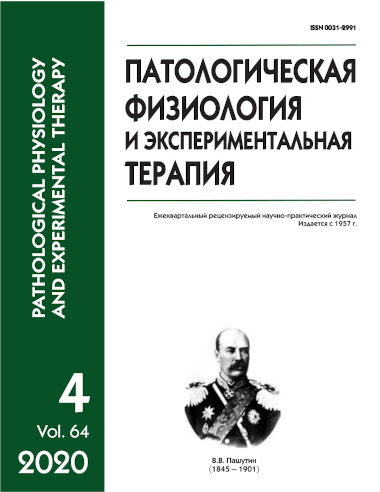Role of vasculoendothelial growth factor in pathogenesis of liver steatosis and dyslipidemia
Abstract
The aim of the study was to assess the role of vascular endothelial growth factor (VEGF) in the pathogenesis of nonalcoholic hepatic steatosis and dyslipidemia in patients with signs of metabolic syndrome.
Methods. 35 patients with nonalcoholic fatty liver disease, including 22 women and 13 men, were evaluated. The sex- and agematched control group consisted of 12 people without liver pathology and metabolic syndrome criteria. Presence of hepatic steatosis was confirmed by an ultrasound examination. The Fatty Liver Index (FLI) and the Hepatic Steatosis Index (HSI) were calculated for patients with hepatic steatosis. Concentrations of proinflammatory cytokines and VEGF were measured for all participants. Also, blood biochemistry, including the lipid profile and liver function tests, was analyzed.
Results. In patients with hepatic steatosis, levels of proinflammatory cytokines and VEGF were significantly increased. Also, concentrations of total cholesterol, low-density lipoproteins, and very low-density lipoproteins were higher in patients with the liver pathology than in the control group. Atherogenic coefficient was increased in hepatic steatosis. Significant correlations were observed between VEGF and waist circumference, thymol test, total cholesterol, low-density lipoproteins, very low-density lipoproteins, and atherogenic coefficient. Sensitivity of FLI and HIS was 91.4% and 97.1%, respectively. Also, FLI significantly correlated with HSI and VEGF level.
Conclusion. The study suggested that VEGF, of the main markers of endothelial dysfunction, plays an important role in the pathogenesis of nonalcoholic hepatic steatosis and dyslipidemia in patients with signs of metabolic syndrome.
Downloads
References
2. Bedogni G., Bellentani S., Miglioli L. et al. The Fatty Liver Index: a simple and accurate predictor of hepatic steatosis in the general population. BMC Gastroenterology. 2006; 6:33.
3. Lee J.-H., Kim D., Kim H.J. et al. Hepatic steatosis index: A simple screening tool reflecting nonalcoholic fatty liver disease. Digestive and Liver Disease. 2010; 42(7): 503-508.
4. Pivtorak E.V. Disorders of endothelium function in patients with nonalcoholic fatty liver disease. Jeksperimental'naja i klinicheskaja gastrojenterologija. 2014; 2: 63. (in Russian)
5. Cetindagli I., Kara M., Tanoglu A. et al. Evaluation of endothelial dysfunction in patients with nonalcoholic fatty liver disease: Association of selenoprotein P with carotid intima-media thickness and endothelium-dependent vasodilation. Clinics and Research in Hepatology and Gastroenterology. 2017; 28(3): 290-291.
6. Mazidi M., Rezaiec, P. Kengned A.P. et al. VEGF, the underlying factor for metabolic syndrome; fact or fiction? Diabetes & Metabolic Syndrome: Clinical Research & Reviews. 2017; 11(1): 61-64.
7. Drapkina O.M., Deeva T.A., Ivashkin V.T. Assessment of endothelium function and degree of apoptosis in patients with metabolic syndrome and nonalcoholic fatty liver disease. Terapevticheskij arhiv. 2015; 87(5): 76-83. (in Russian)
8. Bosch J., Abraldes J.G., Fernández M., García-Pagán J.C. Hepatic endothelial dysfunction and abnormal angiogenesis: New targets in the treatment of portal hypertension. Journal of Hepatology. 2010; 53(3): 558-567.
9. Pasarin M., Abraldes J.G., Liguori E. et al. Intrahepatic vascular changes in non-alcoholic fatty liver disease: Potential role of insulin-resistance and endothelial dysfunction. World Journal of Gastroenterology. 2017; 23(37): 6777-6787.
10. Zaharova N.B., Voskresenskaya O.N., Tarasova YU. Angiogenesis and vascular endothelial growth factor in cerebrovascular pathology. Vrach. 2014; 10: 12-14. (in Russian)






